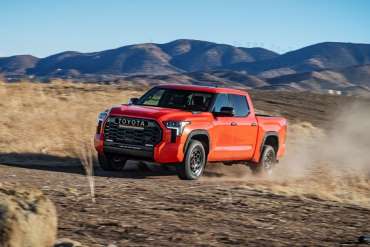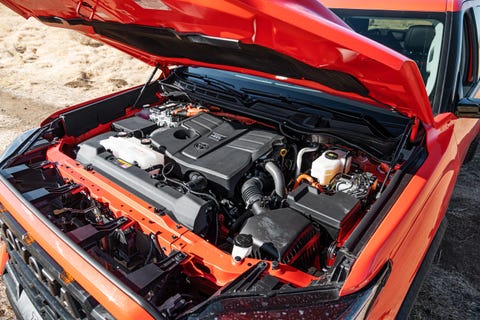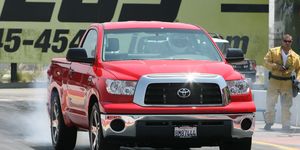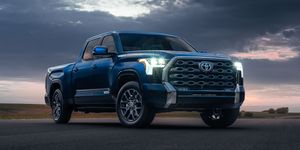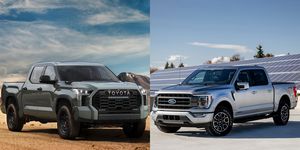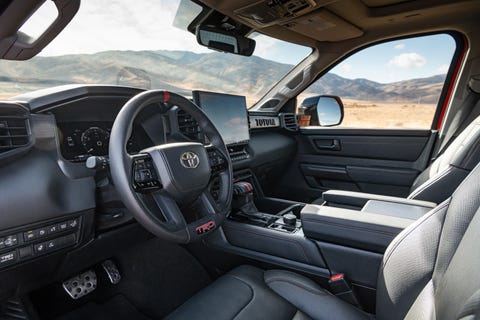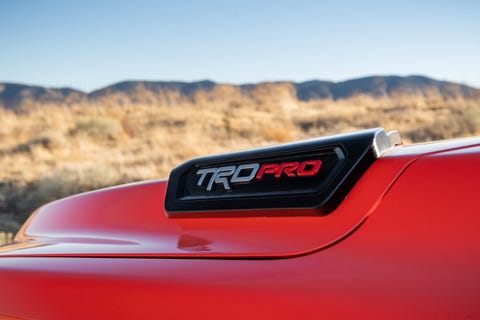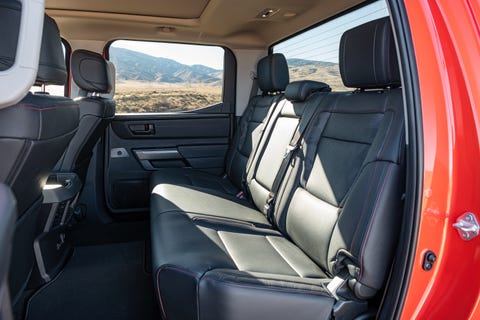The Toyota Tundra is old. How old? It's so old, when it was introduced, the Dead Sea was just getting sick. It's so old, if you park one outside an antiques store, people will try to buy it. It's so old, it was introduced in 2007. Which is, uh, 14 years ago. The fact that Toyota still sells more than 100,000 Tundras a year is a testament to the effort it expended on that mid-2000s redesign—a 381-hp V-8 was killer then and still relevant now. But it's (long past) time for an update, and so the 2022 Tundra gets a thorough overhaul that sets Toyota up for another long production run. Maybe not 14 years this time, though.
The other major hardware change concerns the rear suspension, which is now a coil-spring design. Optional air springs enable automatic load leveling but can also be manually controlled, to either lower the rear end to ease loading or raise it for off-roading. Which, given the fixed front ride height, means that the Tundra can Carolina Squat itself.
Trim levels mirror the previous-gen truck, starting with the basic SR and the volume-model SR5 and climbing through fancier Limited, Platinum, and 1794 variants. The TRD Pro is now hybrid-only, but the hybrid-adverse can build an SR5 that nearly replicates the TRD Pro's hardware. The new TRD Off-Road package includes TRD wheels and suspension (though not the Pro's Fox internal-bypass front dampers and remote-reservoir rears), along with a locking rear differential—the first time an electronic locker has been offered on a Tundra. If you want to go in the opposite direction, there's also a TRD Sport package that lowers the ride height.
JESSICA LYNN WALKERCAR AND DRIVER
From the outside, the Tundra's redesign is conservative—huge grille notwithstanding—with a definite Silverado resemblance in the cab, particularly the upward kick of the sheetmetal at the bottom of the rear side windows. But inside, it's a huge departure from its predecessor. An 8.0-inch center touchscreen is standard, but every truck at the launch event had the optional 14.0-inch infotainment screen. The navigation system is the most obvious upgrade, running a cloud-based system that will automatically store maps offline if you're heading into an area with spotty connectivity. There's also a "Hey, Toyota" virtual assistant that can understand natural questions and commands. One thing that's missing from both systems is a tuner knob for the stereo. If you frequently listen to SiriusXM or terrestrial radio, that could be a major aggravation—the hard buttons on the steering wheel scroll through presets, but not from channel to channel. Up above the rearview mirror is the switch to roll down the rear glass, which is nice for talking to hitchhikers riding in the bed.
With no center differential on any trim, the Tundra's default on-pavement mode is rear-wheel drive. So, take a rear-drive truck with an open diff, 437 horsepower and 583 pound-feet of torque, and you have a recipe for massive burnouts. In our testing, a TRD Pro hit 60 mph in 5.7 seconds, despite refusing to shift at redline (even in manual mode). The quarter-mile is dispatched in 14.5 seconds at 92 mph. That’s quick, but it still lags the 5.4-second zero-to-60-mph dash and 13.9-second quarter-mile we saw from the hybrid Ford F-150 Powerboost, which also undercuts the Tundra’s 6107-pound weight by 313 pounds. Fortunately, the Tundra’s coil-spring rear end helps imbue this three-ton hauler with a feeling of precision that was missing in the 2021 model. The whole truck feels more taut and better in control of its mass, both sprung and unsprung. The TRD Pro’s 0.71-g skidpad result qualifies as decent, given that model's Falken Wildpeak AT3W all-terrain tires.
When it's time to back off the throttle, the hybrid downplays its electrified nature. Although it's recapturing energy on deceleration, there's no display to show that, nor any Prius-style energy deployment graphic. All it has is a gauge showing how much muscle the electric motor is contributing, conspicuously paired with a similar one displaying turbo boost. Where'd that energy come from? Your Tundra won it in a game of poker, or hunted it with a bow and arrow, because that's what tough trucks do.
The fact that Toyota came up with "i-Force MAX" as a euphemism for "hybrid" is a clue that efficiency might not be the main objective here. We still don't have EPA numbers for the hybrid, but the truck's own reckoning from its trip computer put the mileage similar to the nonhybrid, which is to say high teens in mixed driving. We'd guess the i-Force MAX picks up 1 or 2 mpg in the city but doubt it betters the 22-mpg highway for the nonhybrid 4x4. The hybrid will go into EV mode at highway speeds, but with only 48 horsepower motivating a 6000-pound truck, it doesn't take much throttle to awaken the V-6.
Pricing starts at $37,645 for a rear-drive SR double cab, and the fancier trims can cross the $60,000 threshold (that's for the conventional powertrains, with the hybrid pricing as yet unannounced but presumably involving a premium). Toyota admits that it doesn't expect to outsell the domestic trucks, because if the 2007 Tundra couldn't, what would? Thus, three strategic concessions: air springs only on the rear axle rather than all four corners, no generator function with the hybrid, no full-time four-wheel-drive system that can be used on pavement. Because would any of those things convince longtime Ford buyers to jump to Toyota? Conversely, will their absence drive a loyal Tundra driver to another brand? Probably not. If the 2007 Tundra was ahead of its time, this one is of the moment—however long that should last.

